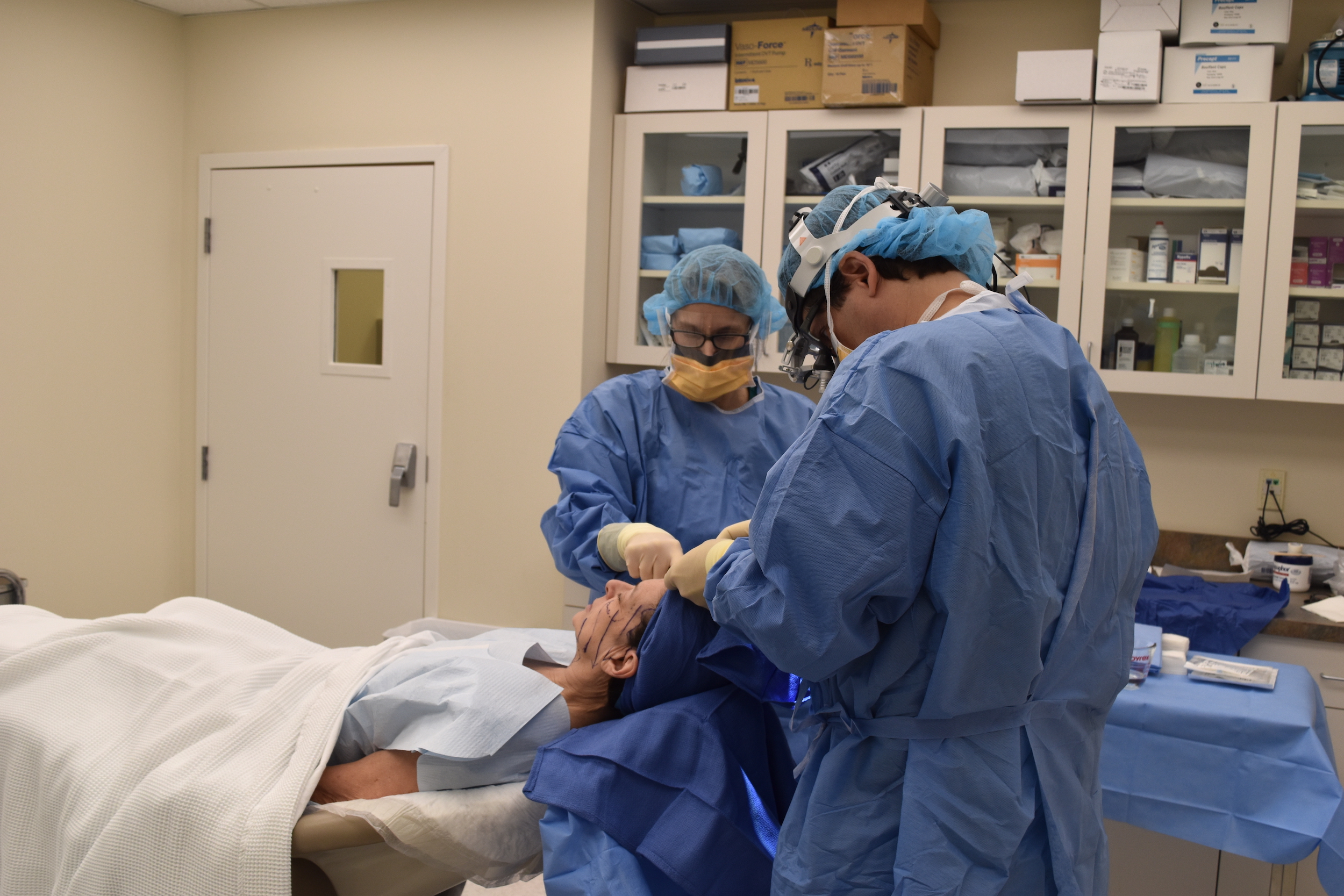- Plastic surgery involves cutting, loosening, and re-sewing parts of the body together.
- There’s nothing plastic about it – the term comes from the Greek word plastikos, which means “to mold” or “to form.”
- The practice dates back thousands of years, to at least the 6th century B.C.
- I spent a day watching a woman get a face-lift, neck-lift, brow-lift, and eyelid-lift, and was amazed.
Plastic surgery is a mysterious business. The average face-lift costs $7,500, though the price can get upwards of hundreds of thousands of dollars, depending on where and how it’s done. Typically, none of that cost is covered by insurance. And after it’s all over, patients often stay hush-hush about whether or not they’ve had any work done.
But in the quiet, picket-fenced town of Avon, Connecticut, patient Kim Maher and Dr. Paul Stanislaw recently let me enter their surgery room and see how plastic surgery happens up close. I was surprised by how low-tech and artful the procedure was, and fascinated by how resilient and tough human faces can be below the skin.
I also learned first-hand that performing or undergoing a face-lift is an all-day slog, with hours of meticulous injecting, snipping, and stitching. The following photos give you a brief glance behind the scenes.
But a few warnings are in order first. Please don’t attempt any DIY plastic surgery – the images below show the work of a board-certified professional with 20 years of experience. If you are considering such a procedure, talk to your doctor. And for those who get squeamish about medical matters, beware: The surgery isn’t terribly gory, but there is a bit of blood involved.
When planning a surgery with a patient, Stanislaw often asks them to bring in old photos of themselves so he can get a sense for what their face shape looked like in the past. This is Maher when she was in high school.

As people age, their skin loses elasticity, stretches out, and becomes less supple.

Muscles in the face that we use over and over again to smile and express emotion create creases. Fat that was once well distributed can also clump up and travel down.
"It's like a stretched-out Slinky," Dr. Stanislaw said. "We're taking out a couple of links of that extra stretched-out Slinky to sort of tighten up."
Maher lost 30 pounds recently, and she said she now believes her face defies her age. "I look like I'm going to be turning 60, and not 53," she said.

About a year and a half ago, Maher decided to change her eating and drinking routines. Today, she said she maintains her weight by taking daily walks and being mindful not to overeat like she used to.
"I walk like crazy," she said. "I walk between 6 and 10 miles a day. So everybody thinks 'oh, you lost all this weight,' but you know what, it didn't come off for free. I really work at it to keep it off."
Maher didn't think there would be a dark side to losing that weight.
"I feel like I'm 20 years old again, but then I look in the mirror and it's like, Oh God, what happened?" she said. "It made me look even older."
So Maher went to Stanislaw to get a face-lift, neck-lift, brow-lift, and upper-eyelid-lift.

They began the day of procedures at 8:30 a.m. The first order of business: Stanislaw mapped out his plan for where Maher's skin should go.
He did this planning while she was seated with her face in an upright position. This helps the doctor keep track of where he wants things to end up once a patient is laying down and he has started cutting and moving things around during surgery.
Stanislaw gifted this surgery to Maher for free. He said he does this occasionally for patients who may not be able to afford the full price out of pocket.

Maher said getting these surgeries done for free feels "like winning the lottery."
She isn't a stranger to plastic surgery: She had two fat pads removed from under her eyes last year by Stanislaw, at a price of $6,200.
This time, she's in for a more elaborate set of procedures, which would ordinarily total to $18,500.
"It's sort of just like a feel-good thing," Stanislaw said.
In the surgery room, Stanislaw keeps an array of mug shot-style photos of his patient on the wall in case he needs to reference their face shape during the process.

Before I stepped inside the operating room, Stanislaw warned that anything draped in blue was a sterile field. I had to keep my hands off those parts of the room.

Sterile areas are reserved for the doctor and his assistant, who both wear masks and gloves. The operating room is kept at 65 degrees Fahrenheit, which felt freezing cold to me. Stanislaw and his assistant prefer it this way. Otherwise, they get too hot performing surgery in their gowns.
They gave Maher some blankets to lay under.
Maher was on a reclining chair that looked a lot like the one at a dentist's office. Once she was situated, Stanislaw began injecting local anesthetic all over her face.

Local anesthesia means that face-lift patients stay awake the whole time. Stanislaw said that if all goes well, this numbing period should be the most painful part of the whole operation.
When he first began doing plastic surgeries two decades ago, he said, most patients opted to go to the hospital and be put to sleep for face-lifts. But today, Stanislaw estimated that about 80% of his patients get their work done in his office, like Maher did.
Stanislaw thinks people may be getting more hesitant to do face-lifts in hospitals because of fears about infection rates. Plus, it's cheaper to have the work done at a clinic because there's no anesthesiologist.
"Man in the Mirror" played on the radio as the surgery began. Maher noticed a tickling sensation in her face from the anesthetic. "Make sure I'm numb when you start with the knife!" she said.

The devices the doctor used to cut open her face looked more like scissors than knives. I heard a snipping sound as Stanislaw began cutting into the skin.
The first place the doctor opened up was Maher's chin.

Stanislaw loosened thin sheets of muscles called bands so that he could lift and reattach them to "get a better neck result."
Muscles from the neck travel all the way up into the face, mid-way between our cheek and ear. So Stanislaw was essentially grabbing and dragging these muscles up. That's why they call it a lift.
Next, he peeled back her right cheek. This was the goriest part of the procedure so far.

The procedure is technically called a "deep plane face-lift."
I was told that some medical students sometimes faint at this juncture. But I found it fascinating and marveled at the thickness of the colorful insides of the human face.

There were so many hues on the inside of Maher's cheek: The thin pink muscles looked like stalactites and stalagmites in a cave, and I saw plenty of yellow material as well.
"Yellow is fat," Stanislaw said.
Who knew there was so much fat inside our faces?
As the doctor prepared to make his first stitches, he told Maher, "you're going to start feeling tight, alright?"

The entire operation was done with a few pairs of scissors, some tools for holding skin up, and these tiny stitching needles that look like fishing hooks.
There were only two big machines in the room. One was hooked up to a pair of vibrating pneumatic compression stockings that were wrapped around Maher's legs to prevent blood clots.
The other machine, called an electric codorizer, is basically a soldering tool for the face: It's used like a tweezers in case any blood vessels bleed during surgery. I only saw the doctor use it a handful of times. Most of his time was spent handling scissors, sutures, and hand tools that hold the skin in place while he works.
There was nothing plastic about the surgery. The word "plastic" does not refer to the material — it comes from the Greek word plastikos, which means "to mold" or "to form."

The procedure really involved sewing up the face with needles and sutures, which come in an array of different sizes (as the photo above shows).
People have been performing different feats of plastic surgery for thousands of years. Perhaps a more fitting name would be something like "skin sewing."
Aside from the peek inside the fatty cheek, the other gross part of watching a face-lift was seeing extra skin dangling off the edge of the face.

That extra skin gets trimmed away as part of the procedure.
Stanislaw spent much of the day perched over his patient in different positions — sometimes he sat on a stool, while in other moments he stood wide-legged with his feet turned out.

Stanislaw stitched Maher's face up with near-invisible threads. The stitches on the sides of the forehead - the part shown in the photo above - raise a persons' eyebrows, repositioning the highest point of the arch "to make you look less tired," Stanislaw said.
Some clear sutures were left to dissolve inside the face over time, while other surface stitches were taken out after about a week.
"It's not like open-heart surgery," Stanislaw said. "It's me being absolutely meticulous with these little little tiny stitches. There's like a thousand little tiny stitches, because the smaller those stitches are, and the better I put those stitches in, the nicer the scars are."

After over seven hours of work, the doctor and his assistant sewed Maher's face back together.
By the end, I could already see some bruising on Maher's chin.

Bruising from a face-lift is normal and goes away after about two weeks.
The final step was an eyelid-lift.

Again, I found it amazing to see how resilient the human body is - a fold of droopy skin from the top of our eye can be easily cut away and discarded.
As Stanislaw performed the eyelid-lift, he took a quick peek at the pictures of Maher's face posted on the wall. Then he bent down and lifted away a flap of skin. Her eye stitches came out a week later.
By the end of the day, Maher's jawline looked more taught than it did when she came in.

Her nerves were still frozen from the anesthetic injections, though, which is why patients can tend to look "a little crooked" right after surgery, Stanislaw said.
A patient's face generally feels tight after plastic surgery, and there is almost always some bruising. But no bed rest is needed.

Stanislaw forbids his patients from driving for the first week or 10 days after surgery, because he doesn't want them jerking their necks around. But as patients recover, they're free to walk around as long as they avoid vigorous exercise.
After about two weeks, the bruising diminishes, and the stitches get pulled out. After a month, people can go back to more normal activities.
Of course, a person who has gotten a face-lift doesn't have any plastic in their body. They've just had some skin removed, and their muscles have been lifted, molded, and formed into a new shape.
As Stanislaw put it, plastic surgery is essentially just "repositioning stuff that's fallen from age" and "making the skin container smaller."

